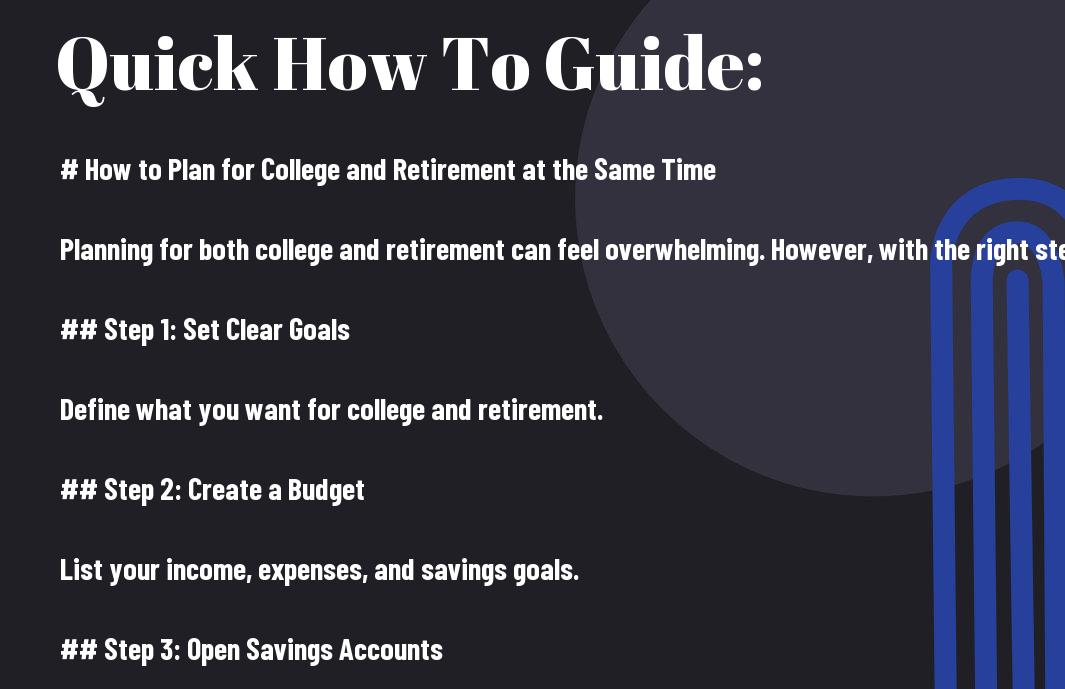You may feel overwhelmed trying to balance saving for college and planning for retirement. These two goals are important and can seem conflicting. However, with the right strategies, you can successfully manage both. In this guide, we will explore practical steps to help you create a solid plan that accommodates your educational aspirations and future financial security. Let’s explore effective ways to ensure you get the best of both worlds without compromising your dreams.

Key Takeaways:
- Make a budget that includes savings for both college and retirement. This helps you keep track of your money and plan effectively.
- Explore financial aid options for college, like scholarships and grants. These can reduce the cost of education and free up money for retirement.
- Consider starting an early retirement savings account, such as a Roth IRA. Even small contributions can add up over time and provide more financial security in the future.


Understanding the Importance of Planning
The importance of planning cannot be overstated. Whether you aim for higher education or a comfortable retirement, having a clear plan is important. It helps you allocate your resources effectively and ensures you meet your goals. By planning now, you can avoid financial stress later, making your path to college and retirement smoother and more manageable.
Why Planning for College Matters
Clearly, college is a significant investment in your future. The average cost of tuition keeps rising, which means you need to prepare financially. By starting early, you can save money, explore scholarships, and reduce your student loan debt. A thoughtful plan allows you to focus on your studies rather than worrying about finances.
The Necessity of Retirement Planning
Even if retirement feels far away, planning for it now is wise. You want to enjoy your golden years without financial worry. Saving early can lead to larger retirement funds due to compound interest, which means your money grows over time. The earlier you start, the easier it will be.
Necessity drives the importance of retirement planning. According to a report, about 30% of Americans have no retirement savings at all. This can lead to financial struggles in later years. You should consider different options like 401(k) plans or IRAs. Set a realistic monthly savings goal to build your fund. Keep evaluating your plan regularly to adjust for changes in your life or financial situation. Planning now means you can enjoy a secure and stress-free retirement later.
Assessing Your Financial Situation
Some people find it challenging to juggle saving for college and retirement at the same time. To do this effectively, you need a clear picture of your finances. Start by checking your savings, debts, and monthly expenses. For additional insights, look into top tips when saving for both college and retirement. This information will help you make informed decisions about your savings goals.
Gathering Financial Information
Assuming you fully understand your current financial state begins with gathering important information. Collect details about your assets, such as bank accounts, savings, and investments. You’ll also want to list any debts, like student loans or credit card bills. This data gives you a foundation to build your financial plan.
Evaluating Income and Expenses
To adjust your budget for college and retirement, you need to evaluate your income and expenses. Start by listing all sources of income, including your salary, side jobs, and any additional money you might receive. Next, track your monthly expenses. This includes rent, utilities, groceries, and entertainment.
Situation analysis can provide valuable insights into your financial health. Identify areas where you can cut back on spending. For instance, if you find that dining out takes a large chunk of your budget, consider cooking at home more often. This reassessment allows you to allocate more funds towards both college savings and retirement contributions, helping you balance immediate and future financial goals effectively.
Setting Clear Goals
Now, it’s time to set clear goals for both college and retirement. This step is vital as it helps you create a roadmap for your future. By outlining what you want to achieve, you can make smarter decisions today. Having well-defined goals will guide your planning and keep you focused on what truly matters. Break these goals into short-term and long-term objectives to help you track your progress effectively.
Defining College Goals
While thinking about college, consider what your objectives are. Do you want to pursue a specific degree? Will you attend a community college or a university? Also, factor in the expenses for tuition, books, and living costs. Clearly defined college goals will help you steer your academic journey and financial planning.
Establishing Retirement Goals
There’s a lot to consider when establishing your retirement goals. Start by deciding at what age you want to retire. Research how much money you will need to maintain your lifestyle after you stop working. It can be helpful to set both savings goals and investment goals.
The average American needs around $1 million saved for a comfortable retirement. To reach this, think about how much you can contribute annually to your savings and investment accounts. Consider factors like your current age and when you plan to retire. This will help you determine how much you should save each month. Balancing expenses for college and retirement requires careful thought, but with well-defined goals, you will be on your way to achieving both.
Exploring Funding Options
To plan for college and retirement at the same time, you need to explore various funding options. Balancing both can feel overwhelming, but understanding available resources will help. Start by looking into different ways to pay for your education and save for your future. This way, you can make informed decisions that benefit both your present and future financial goals.
College Funding Sources
Funding for college can come from several sources, including scholarships, grants, federal loans, and work-study programs. Scholarships and grants are excellent because you don’t have to pay them back. Loans need to be repaid, so it’s important to borrow wisely. Work-study allows you to earn money while studying, helping you cover expenses.
Retirement Savings Accounts
Accounts designed for retirement savings are imperative for your future financial well-being. These accounts include options like 401(k)s and IRAs that offer tax advantages. Investing early can lead to significant gains over time, allowing your money to grow without being taxed until withdrawal. This growth can be vital during your golden years.
Retirement accounts come in various types, each with unique benefits. A 401(k) is often employer-sponsored and can include matching contributions, which is free money towards your retirement. Traditional IRAs and Roth IRAs are also popular, offering tax benefits depending on your contributions and withdrawals. Choosing the right account, and starting early, can maximize your savings, ensuring you have a comfortable retirement while also funding your college journey.

Creating a Budget
Not having a budget can lead to financial stress, especially when you are planning for both college and retirement. A well-structured budget helps you track your spending and saving. Start by listing your income sources and all your expenses. This way, you can see where your money goes. Prioritize your goals, and adjust your spending to make room for both college and retirement savings. A good budget can help you manage your finances effectively and ensure you are on the right path.
Budgeting for College Expenses
You need to identify all the costs related to college, such as tuition, books, supplies, and living expenses. Create a detailed list of these items and estimate how much you will spend each semester. Look for scholarships, financial aid, or part-time jobs to help cover these expenses. By understanding what you need to pay for school, you can make better financial decisions and ensure you have the funds available when needed.
Budgeting for Retirement Savings
You should start saving for retirement as early as possible. This allows your money to grow over time thanks to compound interest. Aim to set aside a percentage of your income each month. Consider using retirement accounts like a 401(k) or an IRA for tax benefits. Also, check if your employer offers matching contributions, as this can significantly boost your savings.
It’s also important to review your retirement savings plan regularly. Adjust your contributions based on your financial situation. If your income increases, consider increasing your retirement savings too. Keeping track of your progress makes it easier to stay on target and reach your retirement goals. Balancing college expenses while saving for retirement may seem challenging, but a solid budget can guide you toward financial success.
Balancing Short-Term and Long-Term Needs
All students face the challenge of balancing immediate college expenses with long-term retirement planning. It’s important to find a way to effectively allocate your resources so you can enjoy your college experience while also preparing for your future. By prioritizing your needs and setting realistic goals, you can make sure you manage both areas without overwhelming stress.
Strategies for Balance
One effective strategy is to create a budget that includes both your college expenses and your retirement contributions. Start by listing all your income sources, such as scholarships, part-time jobs, or savings. Then, categorize your expenses, including tuition, rent, books, and savings for retirement. This clear overview will help you see where your money goes and how much you can set aside for the future.
Importance of Flexibility
Assuming you can stick to a strict financial plan may not be realistic. Life can throw unexpected costs your way, from emergency repairs to surprise tuition increases. Flexibility in your budget allows you to adjust your spending and saving without sacrificing your mental well-being or financial security.
To achieve true balance, you need to remain adaptable. Regularly review your budget and adjust it based on changing circumstances, such as changes in income or expenses. This will help you stay on track with your college goals while still contributing to your retirement. Staying flexible means you can respond to unpredictability while ensuring you continue to progress toward both short-term and long-term financial goals.
Summing up
Presently, planning for both college and retirement can seem challenging, but with careful steps, you can achieve both goals. Start by creating a budget that prioritizes your spending and savings. Consider opening a dedicated savings account for college while also contributing to a retirement fund. Utilize available resources like scholarships and financial aid for college to lessen your burden. By staying organized and informed, you can effectively balance both plans and secure your future.
FAQ: How to Plan for College and Retirement at the Same Time
Q: What should I consider when planning for both college and retirement?
A: When planning for both college and retirement, you need to consider several factors:
- Budget: Create a budget that includes savings for college and retirement.
- Priorities: Determine which goal is more urgent. Is it your child’s education or your own retirement?
- Timeframe: Understand how much time you have for each goal. The sooner you save, the more you can make grow.
- Investment Options: Look at different investment options. College savings plans often differ from retirement accounts.
Q: How can I save for college and retirement without feeling overwhelmed?
A: To save for both college and retirement without stress, consider these tips:
- Set Clear Goals: Define how much you need for college and retirement.
- Automate Savings: Set up automatic transfers to your savings accounts. This makes saving easier.
- Use Budgeting Tools: Utilize apps or spreadsheets to track your income and expenses.
Q: What are the best savings accounts for college tuition?
A: For college savings, consider these types of accounts:
- 529 Plans: These tax-advantaged accounts help you save for education costs.
- Coverdell ESA: Another tax-advantaged option that can help pay for K-12 expenses as well.
- Regular Savings Account: A simple option if you want more flexibility with your money.
Q: Should I prioritize retirement savings over college savings?
A: While both are important, many experts suggest prioritizing retirement savings because:
- Limited Options: You can borrow for college but not for retirement.
- Longer Timeframe: You generally have more time to save for college compared to how soon you may retire.
However, you should balance both by saving a little for each each month.
Q: How can I ensure I’m on track with both savings goals?
A: To stay on track with your savings goals, do the following:
- Regularly Review Your Plans: Check your progress every few months.
- Adjust Contributions: Don’t hesitate to adjust your monthly contributions based on your financial situation.
- Seek Professional Advice: If possible, consult a financial adviser for tailored assistance.
Key Takeaways
Balancing college and retirement savings can feel challenging, but with careful planning, you can achieve both goals. Start by budgeting wisely, setting clear priorities, and utilizing the right savings accounts. Regularly review your strategies and stay flexible to adjust as life changes. By following these steps, you can build a secure future for both yourself and your family.




